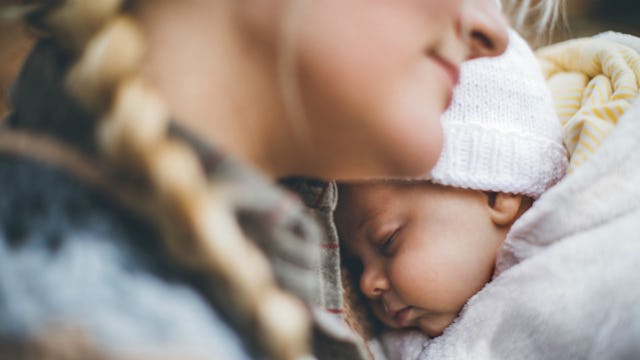This Is What I Learned When My Baby Was Born With Severe Hip Dysplasia

My daughter was stubborn even before she was born.
“She won’t budge,” my OB-GYN said as he removed his hands from my hugely pregnant belly. He’d spent a full five minutes trying to turn her out of the breech position. “I could keep doing this all day, but she’s stuck in your pelvis like an egg in a cup.”
I’d known the 36-week inversion might not work. But with a baby whose head was wedged somewhere between my breastbone and my lungs, turning every one of my breaths into a gasp, I was willing to try anything. I also understood what could come of a breech baby: most certainly a C-section, and possibly congenital issues including hip dysplasia or plagiocephaly, the fancy term for a skull that’s as flat as a pancake in the back.
Sure, I’d heard that in the U.S. up to 3% of babies are born with birth defects, but no daughter of mine was going to have one. I’d tried too hard, for too long, to get pregnant, done prenatal yoga religiously, and never touched soft cheese — even on a trip to Paris! Besides, no one I knew had ever had a kid with a “real” issue. Why would I be the first?
When Lucy was born, she looked like Greg Louganis arched over the diving board in a perfect pike. Her legs were extended straight over her head, and when the pediatrician tried to flatten them out, they sprang right back up. My husband and I were positive something was wrong the second we laid eyes on her. Her hips were wobbly, like they were made of Silly Putty, and her tiny legs just wouldn’t stay down unless we swaddled her tight.
Two days later, a pediatric orthopedist popped my daughter’s out-of-socket hips back into place and announced a diagnosis: Lucy had a severe case of hip dysplasia, and she’d have to wear a harness at least 22 hours a day for three to four months. She’d be forced to hold her legs in an upside-down “U” position so that the ligaments and joints could develop properly, which — if we were lucky — might help her avoid surgery and a lifetime of hip pain.
We trekked to appointments at least once a week, and during one particularly long visit, the orthopedist constructed a special device out of PVC pipe which she wrapped around my daughter’s pelvis so that her legs so would stay stationary. Decked out in her harness, Lucy looked like a baby marionette wearing lederhosen. Except no one was laughing — least of all me.
Where had my vision of a perfect child gone? I’d thrown it out with all the adorable dresses and pants she now couldn’t wear. When I took Lucy out in her stroller, I covered her legs with a blanket — even though it was 90 degrees — just so people wouldn’t stare. More than sore boobs, a weak belly from my C-section, or the relentless exhaustion I felt from being up all night, I experienced a sensation that still makes me hate myself: shame. I didn’t want a daughter who was different. I wanted everything to be fine — and that meant having a baby who didn’t wear a harness.
I went back to work after three months, when Lucy’s doctor’s appointments had become less frequent. At 4 months, she stopped wearing her harness, and at 6 months, the orthopedist proclaimed her good as new.
Around that time, I ran into an old friend on the street. She announced that her 6-month-old son had to have outpatient surgery on his you-know-where. The opening to his urethra was in the wrong place, and it needed to be moved so he could urinate comfortably once he was out of a diaper.
I’m not alone, I suddenly realized, and neither is Lucy. So why have I been telling myself she is?
In the weeks after that, I forced myself to become less guarded and actually talk to people. I started to accept that my daughter wasn’t some rare, fragile doll; she was just a regular kid who’d been born with a complication. And it wasn’t that dissimilar to what others had been through.
“Oliver wasn’t growing enough in the womb,” my college roommate told me, “so I had to be induced. He was only 5 pounds when he was born, with practically no body fat. It took a while for him to catch up.”
“My brother’s baby was born with a club foot,” a colleague said. “A cast and a brace straightened it out in a few months.”
And some people’s experiences made mine look like a walk in the park.
“Jack was born with a rare blood disorder,” a friend at the playground told me. “Luckily, it’s treatable, and we can probably cure it with a bone marrow transplant.”
Despite their issues, all these kids are active, happy, and surrounded by love — not just from their parents, but from their friends and folks like me. Just like every baby, they weren’t born “perfect.” But the truth is that they were never meant to be. When I watch my now 4-year-old navigate the monkey bars and run so fast I can’t catch her, I understand the wisdom that exists in her imperfection. Lucy and all her friends have shown that other parents can be a supportive, judgment-free community — but only when you shrug off your shame and let them.
This article was originally published on